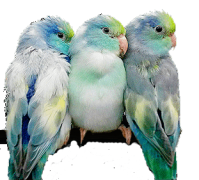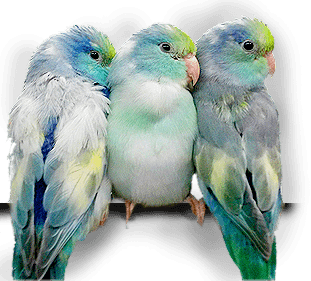 Download the PDF version
Download the PDF version
Pet owners are accustomed to taking the family dog or cat to the veterinarian for an annual checkup, but it is even more important for a pet bird to have an annual checkup. Symptoms of disease in birds are much more subtle and early detection and diagnosis will have a favorable outcome.
Quarantine
Isolation and quarantine of a new bird even those believed to be “healthy” is the first and most important thing an owner can do. In order to protect other birds on the premises, it is advised that all newly acquired birds be maintained separately for a period of at least six weeks. Many airborne viruses can be spread from room to room by central air conditioning or heating systems, so an off-premises location is preferred.
New Bird Examination
The second most valuable step for a new bird owner is to locate an avian veterinarian. Preferably one who is a member of the Association of Avian Veterinarians. Check with local bird clubs, your closest veterinarian to obtain recommendations. The Association of Avian Veterinarians recommends an examination of any newly purchased birds within three days after purchase. If disease is present, the possibility of diagnosis and appropriate treatment is enhanced by early detection. Many serious diseases are not visually evident. Even if the new bird checks out “normal” results of diagnostic tests performed at the initial visit provide valuable reference for subsequent examinations.
Components Of The Exam
History: What you know about the background of your bird such as its age, sex, origin, length of time in household, diet, and caging, can be very important information in determining and maintaining its overall health. Even if the bird has been in a household pet for a long time, the veterinarian should be advised of any contact, direct or indirect with other birds. Indirect Contact: The owner has purchased bulk seed from open bins in a pet shop that houses birds; visited other aviaries, bird shows, or bird markets, these are some examples of indirect contact.
Physical Evaluation
Observation of the bird in a cage may determine general body conformation, obesity, tumors, posture, attitude and character of respiration. Actual hands-on examination is essential for more accurate determination of condition. Although many internal problems may not be evident from physical examination, an experienced Avian Veterinarian is better able to note abnormalities in the feathers, skin, beak, eyes, Ears, nares, oral cavity, bones, muscles, abdomen, and vent.
Weight
Once a bird is an adult, its weight should remain relatively constant. Checking a birds weight, an important part of the annual examination, will give valuable information about the birds health. Weight should be measured in grams, not ounces, to detect small changes. Occasionally weighing the bird at home will provide an idea of comparative gain or loss. Small electronic gram-scales are suitable for home weight comparisons. For a larger bird, be sure the scale goes to the desired weight range.
Testing Procedures
Depending on the bird’s history, results of physical examination, species, age and general condition, your veterinarian may suggest some of the following diagnostic test to further evaluate the bird’s health.
Appraisal of Droppings: The overall appearance of the droppings volume, color, and composition may help the veterinarian assess the bird’s health and consider certain disease conditions. Most birds are nervous in the clinic, so their droppings may be abnormally loose. A fecal sample can be examined microscopically to determine the presence of internal parasites.
Test for Chlamydophila (Parrot Fever)
Several screening tests are available for the detection of Chlamydophila, which used to be called “Parrot Fever” or Psittacosis. This is an important part of the new-bird exam or annual checkup because the causative agent, Chlamydophila psittaci may be transmitted from birds to humans.
Blood Tests
A blood sample might be taken to determine the amount and distribution of blood cells. This information may reveal the possibility of certain diseases and further tests may be indicated for confirmation. A series of chemistry tests performed on the blood sample may point to imbalances in biochemical functions and suggest the possibility of organ dysfunction. Blood parasites may also be detected.
Microbiology
Your avian veterinarian may recommend a culture of the throat (choana) Vent (cloaca), crop (esophagus)or some other tissue/fluid sample to determine abnormal growth of bacteria or yeast. At the same time, antibiotic sensitivity tests may be used to determine an appropriate antibiotic if the bacterial growth requires therapy.
X-rays or Radiographs
Bone fractures, size and relative relationship of internal organs, presence of foreign bodies or soft tissue masses such as tumors, and the condition of the lungs and air sacs are often evaluated with radiographs. The use of anesthesia may be necessary to produce quality radiographs.
Cytology
With the use of special stains a veterinarian skilled in this procedure can evaluate smears of tissues or fluids to assist in making a diagnosis.
Virus Screening
Test are constantly being developed to screen birds for existing and emerging avian viruses. The detection of viruses is especially important for aviary birds. Some viral agents do not appear as clinical disease until the bird is under stress, such as laying eggs, feeding young or at weaning young or being moved to a new home.
Vaccinations
Vaccines are relatively new advance in avian medicine. Ask your veterinarian about current vaccines.
Determining Sex
If you wish to know the bird’s sex and it is not visually discerning, ask your veterinarian about choices available for determining the sex of your bird.
Annual Checkups
Because birds mask symptoms of disease, signs of the beginning stages of disease often go unnoticed. Annual checkups and health examinations are advised for early detection and management of potential disorders. New information about birds is continually being discovered. Occasionally consulting your veterinarian will keep you up-to-date on recent advances in avian medicine.

